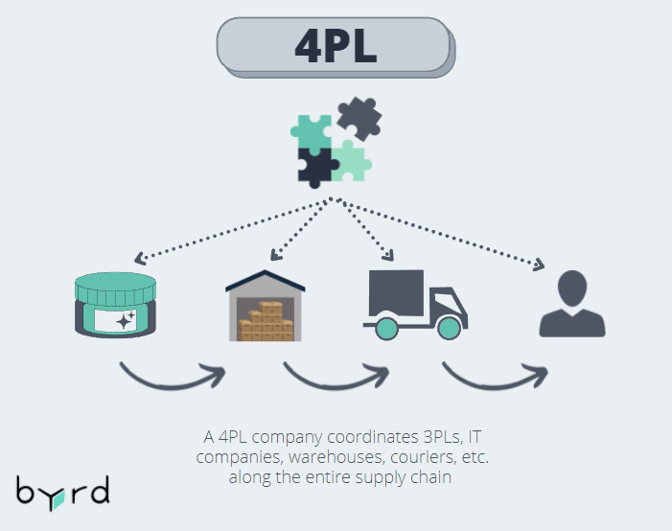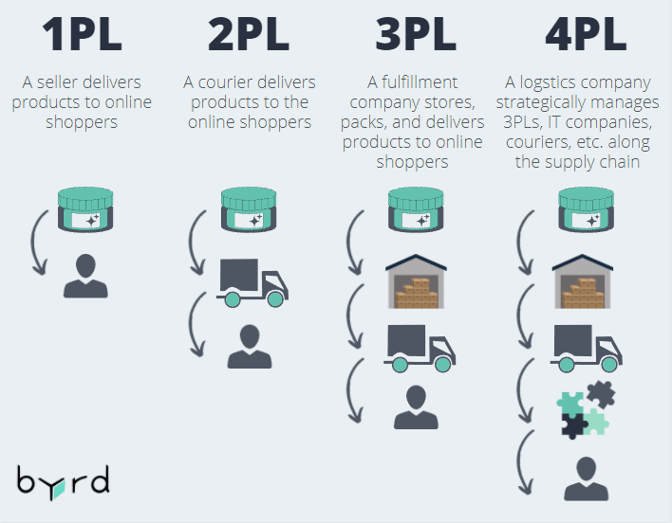3PL vs. 4PL
Table of Content
As an online retailer, you’ve probably come across the terms order fulfillment, 3PL, and 4PL. But what are the differences between 3PL and 4PL services? What are the advantages of 3PL vs. 4PL? Do 1PL and 2PL exist as well? You can find out all of this in our compact article about the most important terms around e-commerce fulfillment.
What is 3PL Fulfillment?
Third-Party Logistics (3PL) service providers enable retailers to outsource elements of their distribution, warehousing, and fulfillment services. 3PL providers distribute storage and staffing costs across many customers and charge for the exact storage space and staff time needed to store products and process orders.
In a 3PL model, a retailer retains management responsibilities but outsources transport and logistics operations to a third-party logistics provider. Additional services such as standard or customized packaging can be provided to add value to the supply chain and customer experience.
The tasks of a 3PL company include:
- Warehousing
- Transport
- Cross-docking
- Inventory management
- Packing
- Dispatch
- Returns
What is 4PL Fulfillment?
A Fourth-Party Logistics (4PL) service provider is an independent market player that takes control of the entire supply chain. 4PL companies, therefore, coordinate the entire logistics process. This includes the development of a long-term logistics strategy and the coordination of several market participants along the supply chain. These players include, but are not limited to:
- IT service providers
- Freight forwarders
- Warehouses
- 3PLs
- Parcel delivery services

3PL vs. 4PL
For most of the growing online merchants, an important decision has to be made at some point: should I work with a 3PL or a 4PL service provider?
Before thinking about this decision, it is key to understand the differences between these 3PL vs. 4PL providers.
Probably the biggest difference between 3PL and 4PL services is the relationship with the online seller.
3PLs have a close but more straightforward relationship with online merchants. The costs for individual services are agreed upon in advance. 3PL service providers then try to meet the expectations. In this way, a 3PL partner enables a successful day-to-day operation.
A 4PL service provider, on the other hand, is more closely involved in the overall decision-making process in regards to the entire supply chain. The focus is clearly on long-term strategy. So, a 4PL company not only offers its networks to enable efficient fulfillment, but is involved in the organization, planning, coordination, and strategy creation of the entire supply chain.
Moreover, 4PLs are one step above 3PLs, so to speak. A 4PL can, therefore, use the services of several 3PLs. Because 4PLs cover a wider range of activities, they are also associated with higher costs.
What is 1PL and what is 2PL?
In addition to the more complex structures of 3PL and 4PL, there are also other logistics setups.
1PL or First-Party logistics, for example, describes companies that use their own capacities to store products and deliver them to end customers. This requires own vehicles, own warehouses, and associated personnel.
By using this strategy, which was standard until the late 1970s, an e-commerce company has 100% control over its own logistics and order processing. However, due to the increasing demands of online shoppers, this option is difficult to implement in a way that covers costs. This is especially true for fulfillment for small and medium-sized companies, but also for established and large businesses. Above a certain number of orders per month, maintaining in-house logistics involves enormous costs and requires years of experience and expertise. This is why the well-known brand Durex, for example, uses byrd‘s 3PL services for their online sales.
2PL or Second-Party Logistics, on the other hand, involves at least one other company than the seller. This second company owns or leases its transport vehicles such as trucks or aircraft. In addition, they often have their own warehouses. A classic example of a 2PL company is a freight forwarder or an airline that offers cargo flights.

Which fulfillment solution suits your e-commerce business?
Which of these solutions best suits your company primarily depends on the number of monthly shipments. As a rule of thumb, there is usually a limit of 100 shipments per month. From this number onwards, in many cases, in-house fulfillment no longer makes sense from an economic point of view.
With more than 100 orders, outsourcing logistics to a 3PL or 4PL company becomes an attractive option. Especially for small and medium-sized e-commerce companies with rapid growth plans, 3PL companies are oftentimes the best solution. However, this also applies to established and large online retailers looking for a flexible logistics solution.
Companies with 5-digit monthly shipment volumes often use the services of 4PLs. They have greater expertise in managing and coordinating the supply chain. However, they also charge accordingly.
Besides the number of shipments, other factors such as the setup of your online shop and the type of products you are selling, are also decisive. These include the number of SKUs or the nature of the goods (size, weight, fragility, dangerous goods, organic, etc.). Last but not least, the geographical location of your customers is crucial. Some 3PL providers like byrd have a fulfillment network that allows you to store your products as close as possible to your customers. 4PLs offer you the same advantages and also allow you to reduce costs and delivery times.
Besides being closer to your end customer, accessing a warehouse network enables you to decentralize your inventory. By doing this, you can enter and conquer new markets.